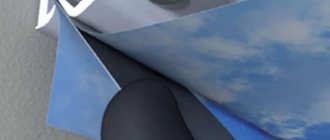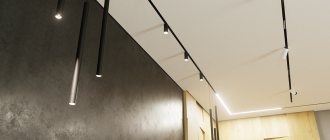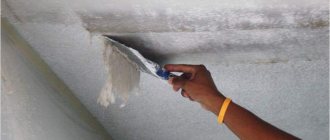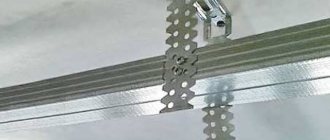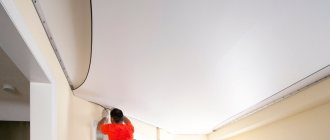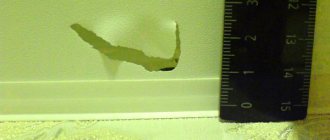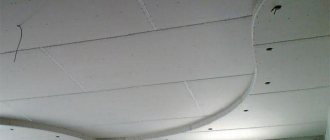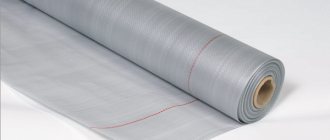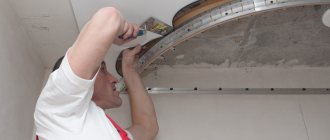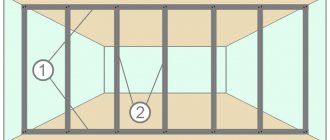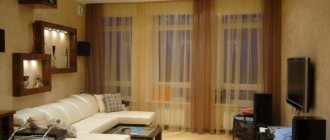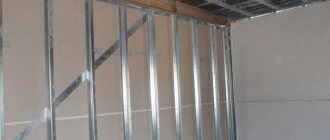SHARE ON SOCIAL NETWORKS
FacebookTwitterOkGoogle+PinterestVk
Unfinished and unfinished things interfere, deprive you of comfort, annoyingly reminding you of their imperfection. This applies to actions, plans, ideas, events, including repairs. A baguette for a stretch ceiling adds completeness and decorativeness to the room. Without it, the joints between walls and ceiling surfaces look sloppy. And the film without a frame remains just a canvas, and not part of the interior composition.
A baguette or installation frame is the basis for the construction of a stretch ceiling
Why do we need profiles for suspended ceilings?
The tension structure is based on a polyvinyl chloride film, which is fixed to the main ceiling using a baguette. The first suspended ceilings appeared in France at the end of the twentieth century; in Russia they learned about such structures only 10 years later. Initially, tension structures were used to correct defects in the ceiling space.
The most important component of a stretch ceiling is the profile, which is a special profile that secures the panel. The standard profile dimensions for suspended ceilings are 2.5 meters, but during the installation process this element is cut to the required length using a grinder.
Before attaching a suspended ceiling to the ceiling, you need to understand all the installation nuances. The beginning of the installation process is fixing the profile around the entire perimeter of the room, then they begin to fasten and tighten the panel. During the installation of a stretch ceiling, a space of about 2 mm remains between the panel and the wall. It is the baguette that serves as a kind of pinching element into which the polyvinyl chloride cloth is inserted.
With the help of various types of baguette for suspended ceilings, large-sized films, 6 * 12 meters and more, are held. In addition, the structure fixed in the profile can withstand a load of more than 20 kg per m2. This method of fastening makes it possible to remove the panel and tighten it again, as well as make adjustments to the stretch ceiling.
The profile can be used many times, which allows you to carry out repair work on the main ceiling or drain water if the neighbors above have a flood. You can install and remove PVC film up to 8 times.
Types of baguettes
To attach polyvinyl chloride film, several types of profiles for suspended ceilings are used:
- Ceiling elements attach PVC film along the edges to the surface of the main ceiling. They are used in cases where it is not possible to mount the structure to the wall.
- Using wall moldings, the panel is attached to the walls around the entire perimeter of the room.
- Special profiles are designed for fixing complex structures, depending on the type of connection and installation location.
- Separating type baguettes are used in rooms whose area is more than 60 m2. In this case, it is possible that the canvas may sag under its own weight. Using a separate profile, structures from several sections are created, two different canvases are connected and columns are bypassed. Separate guides for an inclined type stretch ceiling or double ones allow you to fasten two sheets at once. This is especially true when installing poorly translucent structures; this is how the effect of a starry sky is created.
- Corner profiles consist of two parts that are connected to each other during installation. With the help of such elements, multi-level stretch ceilings are created, panels are connected in the corners and building structures are walked around.
- Structural profiles have notches located at the same distance from each other for more convenient bending. Most often they are used when installing complex structures that involve installing several levels and creating curved ceilings.
In addition, there are visible and invisible profiles for stretch ceilings. In particular, we are talking about the visibility of the baguette due to the edge of the polyvinyl chloride sheet.
Tools and materials
To install the baguette you will need to purchase or prepare the following tools and materials:
- Stepladder.
- Screwdriver.
- Building level.
- Putty knife.
- Hammer.
- Screws, dowels, self-tapping screws.
- Hammer.
A stepladder is required for installation
Plastic baguettes
The PVC ceiling baguette can be called a universal element for installing a suspended ceiling, as it can be combined with any harpoon for the ceiling structure. The lower locking part follows the shape of an aluminum baguette for a stretch ceiling.
Using a visible plastic profile, the canvas is attached to the wall and other vertical surfaces. The fasteners are located at a distance of 10-20 cm from each other. The part of the baguette that remains visible is most often made in white or semi-matte color, its width is about 2.5 cm. When using such a baguette, a visible harpoon of the panel is installed in parallel, so there is no need to use masking tape. Due to the small width of the stretch ceiling baguette, the height loss in this case is only 3 cm.
Invisible baguettes are very popular today; they are also used for attaching canvas to walls and various vertical planes. This molding follows any unevenness of the wall; the fastening is placed in increments of up to 20 cm.
An invisible profile for a suspended ceiling allows you to create curved structures with a radius of up to 20 cm, while there are absolutely no visible steps. In this case, horizontal deflections are made without cuts on the rear wall. In such a situation, the height of the room is reduced by only 2.5 cm. The resulting gap between the ceiling and walls is closed with a special masking tape.
Criterias of choice
The main criteria for choosing a ceiling molding:
- Price. The most expensive are aluminum and backlit profiles.
- Stretch ceiling area. If it is more than 20 sq. m. - only aluminum baguette can withstand.
- Ceiling height. The type of profile design - ceiling or wall - depends on it. The material can be anything.
- Ceiling shape. If it is curved, then an invisible PVC baguette will do. For rectangular rooms, any option is suitable.
- The need for lighting requires the installation of a special design.
- Demanding for decorative solutions.
- Mounting type. It is better to install a profile with a clip lock yourself. If the film ceiling is large in area, then a harpoon mount is needed. For standard rooms you can choose any.
Aluminum baguettes
Installation of a stretch ceiling using harpoon technology is carried out using an aluminum ceiling profile. This allows you to complete the work in a fairly short time and also quickly dismantle the polyvinyl chloride panel. The increased rigidity of the aluminum profile ensures reliability and durability of the fastening, and when making a cut it perfectly holds the angle. It is only important to understand how to attach the profile for a suspended ceiling correctly. The thickness of the front wall corresponds to the optimal value for such structures, so the profile copes well with the tension force of the panel.
Using aluminum profiles, tension structures are attached to the ceiling and any horizontal surface. The height of the ceiling is reduced by only 2 cm; the resulting gap in this case is also masked with a special tape.
Using universal guides for tension ceilings, the canvas is attached to any plane characterized by increased rigidity. Consequently, fasteners can be placed at a distance of up to half a meter. Loss of ceiling height when using universal profiles reaches 3 cm. The gaps that form between the tension structure and the walls during installation are covered with masking tape.
An aluminum wall profile for attaching a stretch ceiling allows you to attach the canvas to a wall and various vertical surfaces. It has increased rigidity, so it can be fixed in increments of up to 20 cm, while not repeating minor wall errors. The loss in room height is significant, its minimum value is 3.5 cm. The resulting gaps between the walls and the suspended ceiling structure are masked with special tape.
Aluminum dividing profiles for suspended ceilings are capable of connecting two tension sheets when it is necessary to bypass building structures or when tensioning the sheet over a large area.
Installation stages
Installation of the baguette is carried out in the following sequence:
- The work is carried out starting from the farthest corner. The profile is applied to the markings, and points are marked with a pencil through the existing holes on the wall.
- Holes for dowels are punched through them using a puncher.
- The profile is secured with self-tapping screws.
- Move on to the next part of the baguette, trying to minimize the distance between them.
- In the corners, the baguette is either attached end-to-end, or the profile is bent and cut for better passage through difficult places. Fasten the profile on both sides of the corner and in the center.
- After fixing the baguette, LEDs are inserted if necessary.
It is better to entrust the installation of the ceiling itself to professionals, as this requires experience and special equipment - a heat gun. Not all methods are available to home craftsmen without industrial equipment. A possible way to install suspended ceilings yourself is to install a seamless ceiling covering made of fabric. With this installation method, a cam-mounted baguette is most optimal. The ceiling tension can be adjusted if necessary. It is better not to take risks with other types of ceilings, so as not to spoil the expensive material.
The decorative baguette is glued after installing the ceiling covering on liquid nails or PVC.
Fastening using glazing bead technology
This option can be called the most inexpensive and accessible fastening of suspended ceilings. In this case, it is necessary to take a polyvinyl chloride sheet slightly larger than the area of the main ceiling. The profiles are fastened at a minimum distance from the base surface, so there is only a 1.5 cm gap between the main ceiling and the tension structure. The PVC film is fixed to the profile in the same way as a plinth, which can be made of plastic or foam.
If the surface has slight curvatures at turns, then you can use flexible inserts. In this case, it is easier to approach the main ceiling to repair it, check the functionality of communications, and drain water in case of flooding from neighbors above.
The only drawback of this technology is the weight limitation of the fabric; only lightweight, seamless polyvinyl chloride film can be used.
Fixing the tension fabric using a wedge method
This type came from Holland; the wedge technology for fastening a stretch ceiling combines high quality and reasonable price. The installation is carried out according to a certain scheme. An aluminum ceiling profile for suspended ceilings is attached around the perimeter of the room, and about 3 cm should be retreated from the main surface. Next, the panel is heated and clamped into a baguette with special wedges. As the film cools, it stretches, resulting in a flat and smooth surface.
Excess polyvinyl chloride film is cut off, but most often it is hidden behind a decorative baseboard. The cost of this technology is slightly higher than that of glazing bead fastening, but in this case the connection between the film and the baguette is much stronger. In addition, a baguette with a wedge fastening lies more evenly on a surface that has small errors. Using this method of fastening the tension fabric allows you to quickly reach the main ceiling for repair work or installation of communication systems.
Features of harpoon technology
The most reliable and at the same time quite expensive technology is the harpoon fastening of the tension panel made of polyvinyl chloride. This method involves doing the following:
- A special edging is made around the perimeter of the canvas, which has the shape of a hook and is made of fairly strong metal.
- Using PVC edging, the film is fixed in a plastic or aluminum profile for suspended ceilings. To do this, preheat the tension fabric and then fix it in the grooves of the profile. First, the tension is carried out diagonally, and then along the perimeter of the ceiling space. As the film cools, it stretches, forming a completely flat surface.
- Thanks to the tension of the canvas during the fixation process, it becomes possible to purchase material of a slightly smaller size.
Harpoon technology has a very important advantage: various types of baguettes can be used to attach polyvinyl chloride film. In addition, there is no need to install decorative skirting boards, since the fastening system of the panel is completely hidden.
Skirting in the interior
For an interior made in a classic style, choose luxurious baguettes with stucco; Also, the wide plinth for the ceiling in the interior is decorated with intricate carved patterns and gilding.
Luxury of classic design Source design-homes.ru
Thanks to the variety of baguettes, the scope of their use extends far beyond the classic solutions; The following options are possible:
For modern trends (including Scandinavian), universal models with a simple profile are suitable. Usually their color is coordinated with the color of the stretch ceiling, which allows you to make it visually higher.
Bedroom in pastel colors Source chestertons.com
In more stylistically pronounced styles, such as loft or hi-tech, a laconic baguette is also used. It is possible to have either a ceiling plinth in the color of the walls or in contrast; lighting would be appropriate.
Loft bedroom Source hzcdn.com
